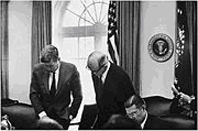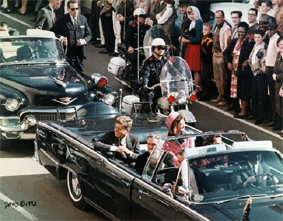FOREIGN POLICY AND KENNEDY'S ASSASSINATION
Major events during Kennedy's presidency included the Bay of Pigs invasion, the Cuban Missile Crisis, the building of the Berlin Wall, the Space Race, early events of the Vietnam War, and the American Civil Rights Movement.
Bay of Pigs (April 17, 1961)
In hopes of overthrowing the lefist Castro's regime and communism, Kennedy and his young cabinet drew the Bay of Pigs operation.
On April 17, 1961, Kennedy gave orders allowing the previously planned invasion under Eisenhower to proceed with support from the Central Intelligence Agency (CIA) .The CIA trained an army of anti-Castro exiles in Central America-which were transported in Cuba for an invasion of that country. The invasion was expected to meet with popular support. Castro's forces crushed the invaders in two days. The failure of invasion was attributed to two factors: to Kennedy's deciding not to supply air support and the Cuban people not rising up to support the invaders. After 20 months, Cuba released the captured exiles in exchange for $53 million worth of food and medicine. The incident was a major embarrassment for Kennedy, but he took full personal responsibility for the debacle.
Cuban missile crisis (October 1962)
The Cuban Missile Crisis began at October 14, 1962, when American U-2 spy plans took aerial photographs of a Soviet intermediate-range missile site under construction in Cuba. Kennedy faced a dilemma: if the U.S. attacked the sites it might lead to nuclear war with the U.S.S.R; if the U.S. did nothing, it would endure the perpetual threat of nuclear weapons within its region. Another fear of Kennedy's was that if the U.S. did nothing, it would appear to the world as weak in its own hemisphere.
 Kennedy ordered a naval blockade in which the U.S. navy inspected all ships and he began the negotiations with the Soviets. He ordered the Soviets to remove all “defensive” material that is being built off the Cuban Island. Without doing so, the Soviet people would face a naval blockade, as well as Cuba. A week later Soviet premier Khrushchev sent Kennedy a message implying that missiles would be removed if America pledged not to invade Cuba and Kennedy agreed not to attack. Khrushchev also promised to remove U.S. ballistic missiles from Turkey within six months. Kennedy ordered a naval blockade in which the U.S. navy inspected all ships and he began the negotiations with the Soviets. He ordered the Soviets to remove all “defensive” material that is being built off the Cuban Island. Without doing so, the Soviet people would face a naval blockade, as well as Cuba. A week later Soviet premier Khrushchev sent Kennedy a message implying that missiles would be removed if America pledged not to invade Cuba and Kennedy agreed not to attack. Khrushchev also promised to remove U.S. ballistic missiles from Turkey within six months.
The two nations had retreated from the brink of the war.
Nuclear Test Ban Treaty (1963)
Troubled by the long-term dangers of radioactive contamination and nuclear weapon proliferation, Kennedy pushed for the adoption of a Limited or Partial Ban Test Treaty, which prohibited atomic testing on the ground, in the atmosphere, or underwater, but did not prohibit testing underground. The US, U.S.S.R. and the United Kingdom agreed to sign the treaty into law in August 1963.
The Civil Rights movement
The turbulent end of the state –sanctioned racial discrimination was one of the most pressing issues of Kennedy's era. The U.S. Supreme Court had rules in 1954 that racial segregation in public schools would no longer be permitted. However, many schools, especially in southern states, did not obey the Supremes Court's injunction. Segregation in buses, in restaurants, movie theaters, bathrooms, and other public places remained. Kennedy supported racial integration and civil rights.
Kennedy's assassination (November 22, 1963)
John Kennedy had gained world prestige by his management of the Cuban missile crisis and had won great popularity at home. Thinking ahead to his reelection in 1964, he went to Dallas for a political appearance.
 Riding in a motorcycle, he was struck by two bullets and died a half- hour later. Lee Harvey Oswald, accused of killing the president, was later shot by Jack Ruby. Riding in a motorcycle, he was struck by two bullets and died a half- hour later. Lee Harvey Oswald, accused of killing the president, was later shot by Jack Ruby.
Chief justice, Warren directed an investigation which uncovered no evidence of a conspiracy. The assassination continues to stir controversy even today. In retrospect, it is clear that Kennedy's reputation stems more from his style and eloquently stated ideals than from the implementation of his policies. He became third (after Martin Luther King, Jr and Mother Theresa) in a Gallup list of he most admired people of the twentieth century.
|

